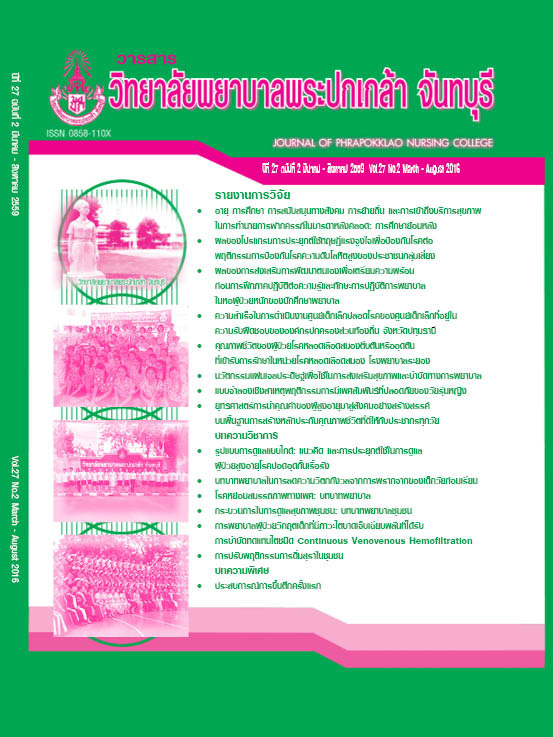Strategies in Promoting Values of Aging People Based upon the Creation to Establish Good Life Qualities for All Ages
Keywords:
Strategy, Values of aging people, Good life quality, All agesAbstract
This mix methods research aimed to explore phenomena, problems, factors, and other related issues concerning the values of aging people in Thai society, and to propose policy guidelines for bringing values of those people to society linking with all ages good life quality. Sample group of 400 general public were survey respondents. Eight key informants for in-depth interviews were scholars and experts. For focus group discussion, 9 experts in the field of aging society were participated. The research instruments consisted of 2 sets of questionnaires with the reliability of .85 and .87, and a structured interview guide. Data collections were conducted from April to August, 2015. Statistics used for data analysis included mean and standard deviation. Also, content analysis was applied for qualitative data.
The results of the study revealed that the opinions regarding the values of aging people were quite positive. In order to integrate the work relating aging people, Thailand should set a five-level strategy framework to creatively carry forward the values of aging people to society, which was in the light of quality of life insurance for all ages. The five-level strategies were 1) a national-level strategy – to promote the values and experiences of aging people to society, 2) a provincial-level strategy – to integrate collaboration of work relating aging people in provincial and district levels, as well as local administrations, 3) a local-level strategy – to promote wisdom, activities, and build strengths in bringing potentiality and values of aging people in a local level, 4) a community-level strategy – to promote leadership and community institutions to carry forward good attitude and realization in values of aging people, and 5) a family-level strategy – to strengthen understandings and family bonds to remain aging people as a center of the family. Lastly, all five-level strategies, including each level tactics are proposed in order to holistically and creatively work hand in hand from all levels to bring good quality of life for all ages.
This study suggested that each task function should create aging operation mechanisms which move forward hand in hand under the strengthening structure at all five levels. Besides, a common goal should aim at the betterment of aging people’s life quality.
References
ชาย โพธิสิตา. (2556). ศาสตร์และศิลป์แห่งการวิจัยเชิงคุณภาพ (พิมพ์ครั้งที่ 6). กรุงเทพฯ: อมรินทร์พริ้นติ้งแอนด์พับลิชชิ่ง.
ปราโมทย์ ประสาทกุล, ศุทธิดา ชวนวัน, และกาญจนา เทียนลาย. (2555). ผู้สูงอายุ: คนวงในที่จะถูกผลักให้ไปอยู่ชายขอบ. ใน เอกสารประกอบการประชุมวิชาการระดับชาติ ครั้งที่ 8 “ประชากรและสังคม 2555” ประชากรชายขอบและความเป็นธรรมในสังคมไทย. หน้า 106-124. วันที่ 2 กรกฎาคม 2555 ณ โรงแรมรอยัลริเวอร์ กรุงเทพฯ.
รศรินทร์ เกรย์, อุมาภรณ์ ภัทรวาณิชย์, เฉลิมพล แจ่มจันทร์, และเรวดี สุวรรณนพเก้า. (2556). มโนทัศน์ใหม่ของนิยามผู้สูงอายุ: มุมมองเชิงจิตวิทยาสังคม และสุขภาพ (รายงานผลการวิจัย). กรุงเทพฯ: สถาบันวิจัยประชากรและสังคม มหาวิทยาลัยมหิดล.
วรเวศม์ สุวรรณระดา, และรักชนก คชานุบาล. (2557). การขับเคลื่อนงานด้านผู้สูงอายุเพื่อรองรับการเข้าสู่ประชาคมอาเซียน (รายงานผลการวิจัย). กรุงเทพฯ: วิทยาลัยประชากรศาสตร์ จุฬาลงกรณ์มหาวิทยาลัย.
ศิริวรรณ ศิริบุญ, และชเนตตี มิลินทางกูร. (2551). การเปลี่ยนแปลงในขนาดและสัดส่วนของ “ผู้สูงอายุ”. สืบค้น วันที่ 28 เมษายน 2558, จาก http://www.cps.chula.ac.th/cps/research_division/article_aging/aging_001.html
สำนักงานคณะกรรมการพัฒนาการเศรษฐกิจและสังคมแห่งชาติ. (2557). คุณค่าผู้สูงอายุในสังคมไทย. ภาวะสังคมไทยไตรมาสหนึ่ง ปี 2557, 11(2), 18-22.
อรทัย อาจอ่ำ. (2553). แก่แล้วไม่มีคุณค่าจริงหรือ?: บทสังเคราะห์ความรู้เกี่ยวกับคุณค่าของผู้สูงอายุ. ใน เอกสารประกอบการประชุมวิชาการระดับชาติ ครั้งที่ 6 “ประชากรและสังคม 2553” คุณค่าผู้สูงอายุในสายตาสังคมไทย. หน้า 167-184. วันที่ 1 กรกฎาคม 2553 ณ โรงแรมรอยัลริเวอร์ กรุงเทพฯ.
Bond, J., Peace, S. M., Dittmann-Kohli, F., & Westerhof, G. (Eds.). (2007). Ageing in society (3rd ed.). London: SAGE publications.
Debavalya, N. (2008). Aging policies and programmes in Thailand. In Guan, L. H. (Ed.). Aging in south east asia: Family, social protection and policy challenges. Singapore: Institute of Southeast Asian Studies.
Rudinger, G., & Thomae, H. (1990). The Bonn longitudinal study of aging: Coping, life adjustment, and life satisfaction. In Baltes, P. B., & Baltes, M. M. (Eds.). Successful aging: Perspectives from the behavioral sciences. pp. 265-295. Cambridge: Cambridge University Press.
United State Census Bureau. (2015). International Data Base. Retrieved June 15, 2015, from http://www.census.gov/population/international/data/idb/informationGateway.php
Yamane, T. (1973). Statistics: An introductory analysis (3rd ed.). New York: Harper and Row.
Downloads
Published
How to Cite
Issue
Section
License
Copyright (c) 2016 Journal of Phrapokklao Nursing College

This work is licensed under a Creative Commons Attribution-NonCommercial-NoDerivatives 4.0 International License.
เนื้อความ ข้อมูล และรายการอ้างอิงที่ผู้เขียนใช้ในการเขียนบทความเพื่อลงตีพิมพ์ในวารสารวิทยาลัยพยาบาลพระปกเกล้า จันทบุรี ถือเป็นความคิดเห็นและความรับผิดชอบของผู้เขียน คณะผู้จัดทำวารสารไม่จำเป็นต้องเห็นพ้องด้วยหรือร่วมรับผิดชอบ
บทความที่ได้รับการลงตีพิมพ์ในวารสารวิทยาลัยพยาบาลพระปกเกล้า จันทบุรี ถือเป็นลิขสิทธิ์ของวารสารวิทยาลัยพยาบาลพระปกเกล้า จันทบุรี หากหน่วยงานหรือบุคคลใดต้องการนำส่วนหนึ่งหรือทั้งหมดของบทความไปเผยแพร่ต่อเพื่อวัตถุประสงค์ใด ๆ จะต้องได้รับอนุญาตจากบรรณาธิการวารสารก่อน



